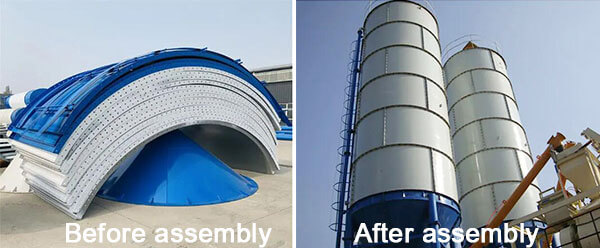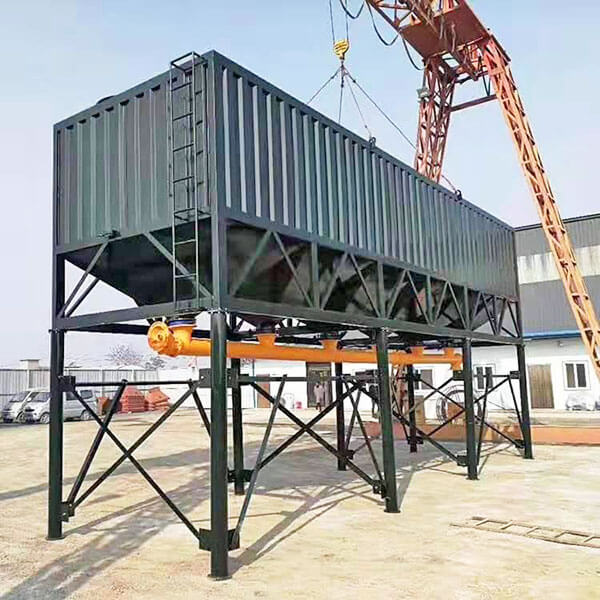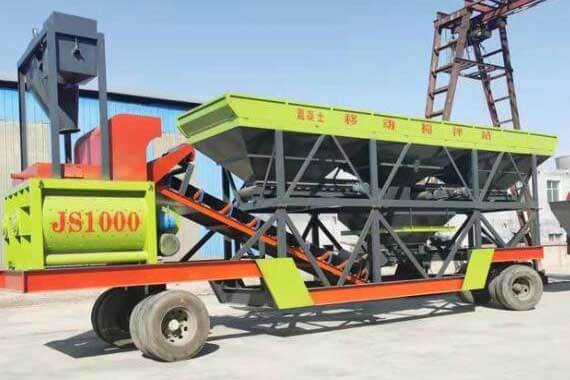[lwptoc skipHeadingLevel="h1,h4,h5,h6"]
What is cement silo?
A cement silo is a container used to store bulk materials. Cement silos are generally used in concrete batching plants and dry mix mortar plants. A large amount of material is stored in the cement silo, there is a discharge port under the cement silo, and the cement can be transported to the place where it is needed through the screw.
Cement silos are mainly used for storing bulk materials safely and efficiently. The material stored in cement silos is usually transported by truck or railcar to the manufacturing site. The material is then unloaded into the plant's storage area. It can be treated using other equipment such as belt conveyors or bucket elevators to transport it from one place to another at various stages of manufacture until it reaches its final destination.
What are the 3 types of silos?
There is generally 3 type of cement silos: vertical cement silo, horizontal cement silo, and portable cement silo.
Vertical cement silo
The vertical type cement silo: This type has a cylindrical shape with a cone bottom and round top. It can be divided into bolt-type and whole cement silo according to the structure. The vertical cement silo used for export is bolted (as shown in the figure below) to save transportation space; it is piece by piece and assembled after arriving at the destination.

Bolted-type cement silo before vs after assembly
The bolted cement silo adopts advanced manufacturing technology. Special equipment and molds are formed simultaneously, with silo body interchangeability, quick installation, firm structure, smooth appearance, no cement leakage, no water seepage, good sealing, detachable, transfer to factories, and recycling. The product is small, easy to transport, and has low transportation cost, suitable for export containerization and domestic long-distance transportation.
The overall vertical cement silo can be used for short-distance transportation, which is large and suitable for short-distance vehicles. Among them, 200T and 300T cement silos need to be customization. The overall cement silo occupies less area and has a long service life and low cost, which is the first choice for most users.
Horizontal cement silo
A horizontal cement silo, also called containerized cement silo, is a closed tank for storing bulk materials, with a reduced height and no installation required. It is environmentally friendly and saves costs for you.

A horizontal cement silo, also called containerized cement silo, is a closed tank for storing bulk materials, with a reduced height and no installation required. It is environmentally friendly and saves costs for you.
Portable cement silo
The protable cement silo is a new convenient mixing plant configuration (as shown in the figure below).

Portabale / Mobile cement silo
The mobile mixing plant is a combination of devices such as feeding, storage, weighing, mixing, and unloading installed on the same base. Such a structure is compact and easy to transfer. It can directly enter the construction site, thereby reducing the distance of concrete conveying, improving economic efficiency, and increasing convenience and availability for small and medium-sized construction or maintenance projects with inconvenient traffic.
Cement silo sizes
Cement silos have different types depending on the type of material they are used for and their dimensions. There are cement storage silos with different size specifications: 25m³, 35m³, 50m³, 70m³ and 100m³ etc., The diameter of these types of cement storage silos ranges from 300mm-500mm.
According to weight, we support custom cement silo models from 30 tons to 2000 tons. The most popular are 50 ton cement silos and 100 ton cement silos.
1000 ton cement silo and 2000 ton cement silo need to be customized according to the site; there is no standardization.
All cement silo capacity is not standard; it also needs to be decided by your material; for example, the output of cement silo for cement and aggregate is different.
Cement silo dimensions can be customized according to the situation of your working site.
Cement silo components
The components of the cement silo are (including some accessories):
- Cement Silo Level Indicator
- Cement Silo Screw Conveyor
- Cement Silo Dust Collector
- Cement Silo Filter Bags
- Bulk Cement Silo Tank
- Cement Silo Butterfly Valve
- Pneumatic Valves
- Cement Silo Calculator
- Outrigger
- Angle Iron
- Ladder
- Guardrail
- Triangle Board
- The Electromagnetic Valve
- Arch Breaking Device
- Sealing Rope
- Gasket
How does a cement silo work?
After the storage bin is fixed, the cement is transported to the construction site by the bulk cement truck, and then the transport pipeline of the bulk cement truck is connected to the feeding pipeline of the cement silo.
The cement in the tank is transported by the gas pressure of the bulk cement truck. Transported to the warehouse. In this process, when transporting cement into a storage bin, operators must press on oscillating motors at any time so as not to block dust collectors.
When it needs to be released, open manual discharge valves at the bottom of the cone bottom and then transport it through a screw conveyor to go where it's needed.
How to measure cement in silo?
The cement silos store cement, fly ash, and other powders in dry mix mortar production lines. However, the cement silo is a sealed cylindrical structure, and its height is generally more than ten meters. After we deliver the cement to the tank, we cannot observe the usage of the powder, so how to measure cement in a silo?
Usually, a cement silo level indicator is installed on the top of the cement storage silo, and we can use it to know how much cement is left in the tank.
During the concrete mixing plant use, the cement continues to decrease. After the sensing device of the material level indicator cannot sense the resistance, it will send a corresponding signal and automatically turn on the power. Click to run, and drive the blade to move down. When it touches the cement, When the edge feels the resistance, it will send a signal and disconnect the power supply. At this time, the blade's position is the position of the remaining powder in the cement silo.
Through the material level meter, we can monitor the use of cement in real-time and replenish it in time, avoiding the shortage of material in the production process.
What should be paid attention to when installing a cement silo?
- In installing the cement silo, abnormal phenomena such as tilting of the silo body and deformation of the outriggers are not allowed.
- The welding between the bottom of the outrigger and the embedded part of the foundation must be firm.
- Do excellent wind and lightning protection for the entire cement silo.
- Take protective measures to avoid the impact of external forces on the outriggers and the silo body.
- Regularly check the cement adhesion on the dust collector bag and clean it in time.
- The silo body foundation of the entire cement silo must be firm and conform to the relevant specifications of architectural design.